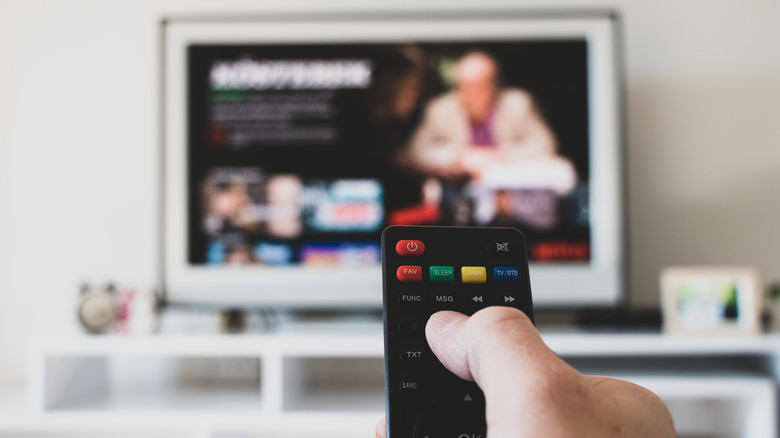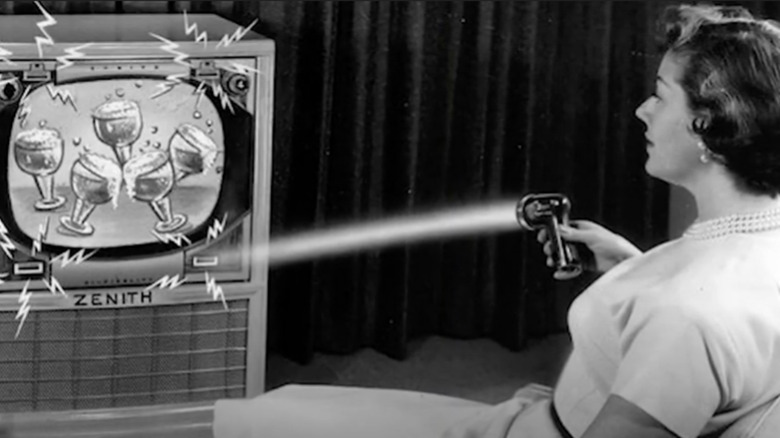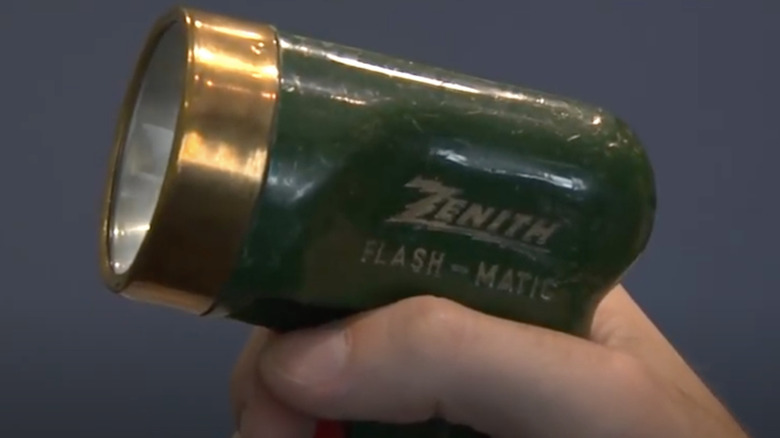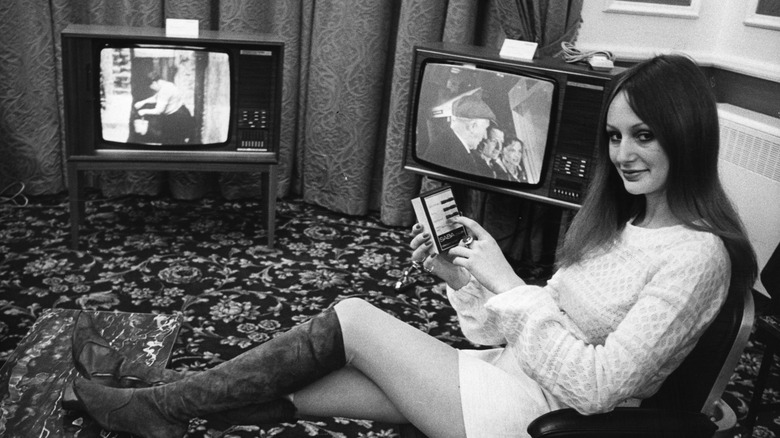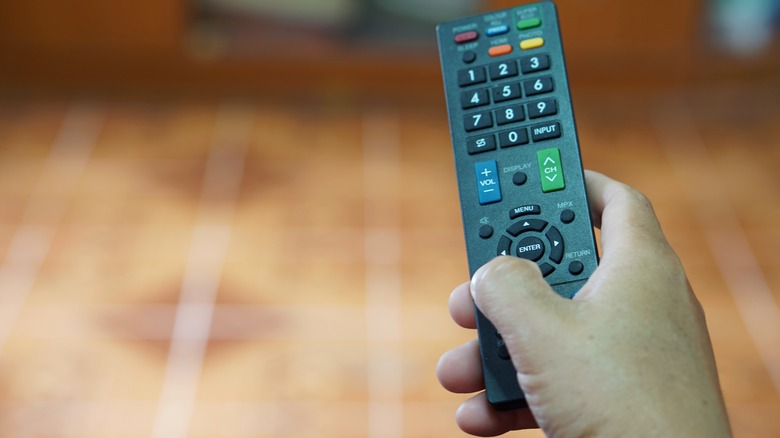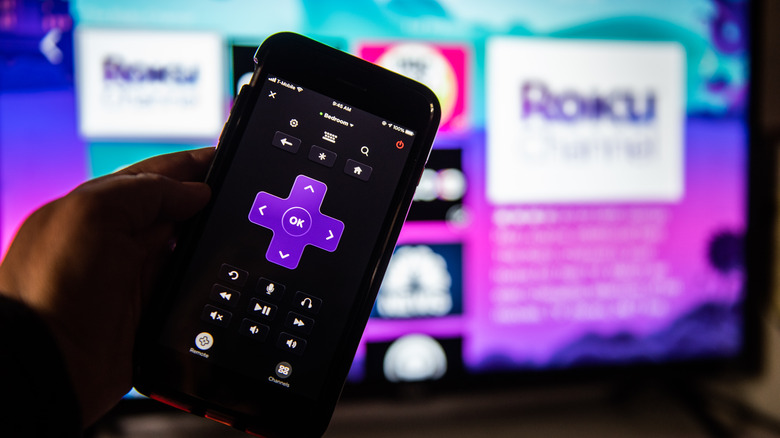The History Of The TV Remote
We may receive a commission on purchases made from links.
The first person to create and patent the remote control was none other than Nikola Tesla, inventor of the Tesla coil and numerous electronic systems (via Britannica). He patented the idea in 1893 to drive boats remotely, far before televisions were invented. Since then, remotes have come a long way, especially for the television, changing from small boxes with long wires to the wireless universal remotes that many people have today. How has the remote evolved over time?
Television was invented in 1927, but it didn't gain much mainstream popularity until the 1940s (via History). Historic Tech reports that in 1950, the Zenith Lazy Bones was invented. As the first TV remote ever developed, it was connected to the TV box with a long clunky wire, which inevitably caused people to trip over it. The Lazy Bones device had only two buttons on it that spun in a circle (via Zenith). The user could change the channel, or turn the TV on or off, but that's all it did. The Lazy Bones remote also cost an arm and a leg, retailing for $30 in 1950, which is around $350 today (via Dollar Times).
No more Lazy Bones
Needless to say, the Lazy Bones design didn't stick around for long (via Historic Tech). It was replaced in 1955, when a new kind of remote control began to take over the market.
Per BBC, the real reason televisions come with wireless remotes was due to Eugene F. McDonald, who was the president of Zenith Electronics. In the 1950s, as television popularity was exploding across the United States, McDonald had a major gripe with his viewing experience. He hated watching advertisements, a relatable annoyance to anyone else who's ever had to sit through commercials. McDonald requested that his employees find a way to combat this, either by skipping the channels or muting the sound, without having to get up and walk to the television.
According to CNET, Eugene Polley, an engineer, developed a novel idea for the product. The Flash-Matic was a bright green device that looked similar to a toy gun, but when you pulled the trigger, it would emit a bright beam like a flashlight.
Did Flash-Matic work?
Zenith advertised that the Flash-Matic could wirelessly change channels, turn the TV off and on, and adjust the volume (via CNET). Each of the four corners of the TV did something different when the Flash-Matic was pointed at it. Along with bragging about their futuristic invention and writing that it took practice to get used to, Zenith strangely included the line, "absolutely harmless to humans!" in their advertising.
Per ThoughtCo., the Flash-Matic had a small caveat — it stopped working in sunlight. A sunny day could randomly change a TV's channels or pump up the volume, which is not exactly ideal.
According to BBC, the remote was due for another upgrade. Researchers thought that radio waves might be the future of the remote control, but for people living in tight spaces, like an apartment complex, that could mean accidentally turning their neighbor's TV set on instead of their own. They also decided that the next remote shouldn't use batteries, as the Flash-Matic did — they believed if the batteries died, people would think their whole remote was broken (via Zenith).
Inventing the clicker
Instead of using a light-activated sensor, for the new remote, it seemed like the future was sound (via Zenith). Engineers tried using specific sounds, but they thought people might get tired of hearing the same blips and beeps every time they channel-surfed. And they worried that other household appliances might mimic the noises too closely.
One member of the team, Robert Alder, came up with the idea to use high-frequency noise, with a pitch too high to be heard by the human ear. He used four thin aluminum rods to control the sound and channels to create the first ultrasonic TV remote control. As BBC notes, some people with excellent hearing, as well as most cats and dogs, did seem to be able to hear these high-pitched frequencies.
Per Zenith, this remote was even more expensive than the Lazy Bones, costing about a third of the price of the television set, and requiring custom installation. But even so, the Zenith Space Command remote was launched in 1956. According to Time, the four little buttons made clicking noises — and that's why people started calling TV remotes "the clicker." The Space Command was the remote of choice for a while, until the next developments in tech around the 1970s (via BBC).
Gaining universal popularity
With the addition of more TV channels came a need to be able to not just click through them one by one, but to type a number to bring the customer to the channel directly (via BBC). The newest remotes weren't clickers, they were silent, since they could use new infra-red light technology instead of high-frequency sounds.
As Slate reports, in 1979, only about 17% of Americans had a remote control. But during the 1980s, remotes went from having four buttons to having dozens that could perform all kinds of complex commands. In 1985, the original Apple co-founder Steve Wozniak tried to do just that with the Core remote (via The New York Times). Not only could the Core control televisions, but it could also control other devices, like stereos. This remote didn't sell well due to its high cost, as Slate reports. It was also way too complex for the average person — it came with a massive instruction manual to control the 20 buttons on the device.
As cable TV grew in popularity, remotes now needed to be able to pause and fast-forward, as well as programming buttons to switch between VCRs and gaming devices. Remotes were gaining popularity fast — by the beginning of the 1990s, more than two-thirds of all American TV owners had one. With many new tech devices, remotes were now automatically included.
The future of TV remotes?
According to How Stuff Works, universal remotes became common enough to be redundant — by the late 1990s, they were included with nearly every TV, as well as many other devices, leading to customer frustration. Instead of embracing remote controls, people began to get sick of them. It was clear that once again, remotes were going to have to evolve with the times.
So what's in store for the remotes of the future? Lots of devices today connect right to your smartphone, eliminating the need for one or ore additional physical devices (via BBC). Not to mention that there are now devices that you can talk to, such as Siri, the assistant for Apple phones, or Alexa, the voice assistant for Amazon Echo devices. Now, you don't have to lift a finger: you can command Alexa to turn the volume up or down, pick a song, write a grocery list, and much more (via Amazon). After ultrasonic and infrared remotes, the next best remote — your smartphone — might already be in your hand.
